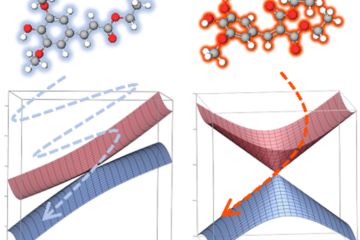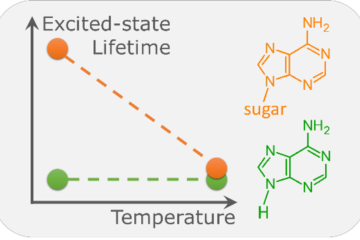Paper sets a new gold-standard for surface hopping.
In brief:
- Surface hopping dynamics of cyclohexadiene based on CASPT2 shows photodissociation within 89 ± 9 fs with 47± 8% quantum yield.
Photoinduced ring opening of 1,3-cyclohexadiene (CHD) is a fundamental example of nonadiabatic molecular reactive processes, acting as a prototype for many other photoinduced reactions in larger systems including those of biological importance. This photochemical reaction has received ample interest from both theory and experiments. For theory, it constitutes an archetypical example of the Woodward-Hoffman rules. Nevertheless, the electronic structure is astonishingly difficult to converge, requiring a high-level treatment of the electron correlation.
CHD dynamics has been simulated with diverse methods, including multiple spawning, mean field Ehrenfest, and surface hopping; and based on different electronic structure methods, from TDDFT to CASPT2. All the previous dynamic studies are prone to limitations of different types, either connected to the description of the nonadiabatic interaction, of the dynamics, or of the electronic density.
In this work, we tried to overcome many of these limitations by simulating the photodissociation of CHD with:
- a complete subspace of three electronic states;
- decoherence-corrected fewest switches surface hopping dynamics (DC-FSSH);
- extended multistate complete active space second-order perturbation (XMS-CASPT2) electronic structure theory;
- fully analytic CASPT2 nonadiabatic couplings;
- significant statistical ensembles;
- initial conditions closely emulating the experimental excitation;
- accounting of double-excitation contributions to the electronic states;
- control of energy conservation due to orbital rotations.
Survey of surface hopping methods and results for the photodissociation of CHD
|
|
This work | Ohta et al. |
Lei et al. |
Schalk et al. |
Filatov et al. |
| PES | XMS-CASPT2 | MS-MR-CASPT2 | CASSCF | LR-TD-PBE0 | SSR-wPBEh |
| Dynamics | DC-FSSH | ZN | ZN | FSSH | DISH-XF |
| Trajectories |
136 |
42 | 600 | 119 | 50 |
|
Decay time (fs) |
73 ± 9 | 47 | 82 | 52 | 234 ± 8 |
|
Latency time (fs) |
16 ± 2 | 21 | 29 | 43 ± 5 | |
|
Dissociation yield (%) |
47 ± 8 | 40 ± 15 | 47 ± 4 | 64 ± 9 | 36 ± 13 |
The nature of the preferred reaction pathways on the exited and ground states is discussed, and extensive comparison to the previously published full dimensional dynamics calculations is provided.
With 47± 8% product quantum yield and an estimated excited-state lifetime of 89 ± 9 fs, our calculations provide a detailed description of the non-adiabatic deactivation mechanism, showing the existence of an extended conical intersection seam along the reaction coordinate. Moreover, we found little correlation between the coordinate where the nonadiabatic transitions occur and the outcome of the reaction.
Moving beyond the CHD discussion, this application is a showcase of the new Newton-X/Bagel interface for surface hopping dynamics based on CASPT2.
This work, led by Iakov Polyak at the Cardiff University, has been published in Ref. [1].
MB
Reference
[1] I. Polyak, L. Hutton, R. Crespo-Otero, M. Barbatti, and P. J. Knowles, Ultrafast photo-induced dynamics of 1,3-cyclohexadiene using XMS-CASPT2 surface hopping, J. Chem. Theory Comp. DOI: 10.1021/acs.jctc.9b00396 (2019).


